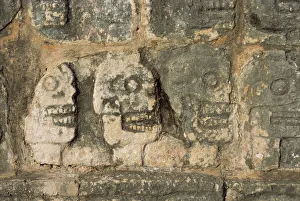Tzompantli Collection
The Tzompantli, a chilling testament to the ancient Aztec civilization, is a sight that both fascinates and horrifies
All Professionally Made to Order for Quick Shipping
The Tzompantli, a chilling testament to the ancient Aztec civilization, is a sight that both fascinates and horrifies. Carvings of skulls on this eerie structure serve as a haunting reminder of the gruesome practices that took place within its walls. Imagine standing before a wall adorned with human skulls, each one meticulously placed to create an intimidating display. This scene comes alive in the Templo Mayor of Tenochtitlan, depicted in coloured engravings like EyeUbiquitous_20104418 and EyeUbiquitous_20104417. But it's not just Tenochtitlan where these bone-chilling structures can be found. Chichen Itza also boasts its own Tzompantli Skull Carvings (as seen in NATL2A-00028), showcasing the Maya civilization's macabre rituals. The skulls of sacrificed men and horses were skewered on horizontal poles for all to see, as illustrated in the Codex Florentino from c1540 by Bernardino de Sahagun. Traveling further into Mexico, we stumble upon another Aztec archaeological site called Calixtlahuaca. Here lies the Temple of Tlaloc and altar of the Skulls or Tzompantli (as captured by photographers). This sacred space was dedicated to honoring death through elaborate ceremonies involving skull offerings. Chichen Itza continues to captivate us with its architectural marvels built by the Maya people. In front of the Temple of Jaguars stands "The Wall of Skulls, " aptly named Tzompantli. Its intricate carvings send shivers down our spines as we contemplate their significance within Mayan culture. These carvings are more than mere decorations; they represent deep-rooted beliefs surrounding death and sacrifice held by these ancient civilizations. The Tzompantli serves as a chilling reminder that history is often filled with dark chapters, and it beckons us to explore the depths of human existence.










